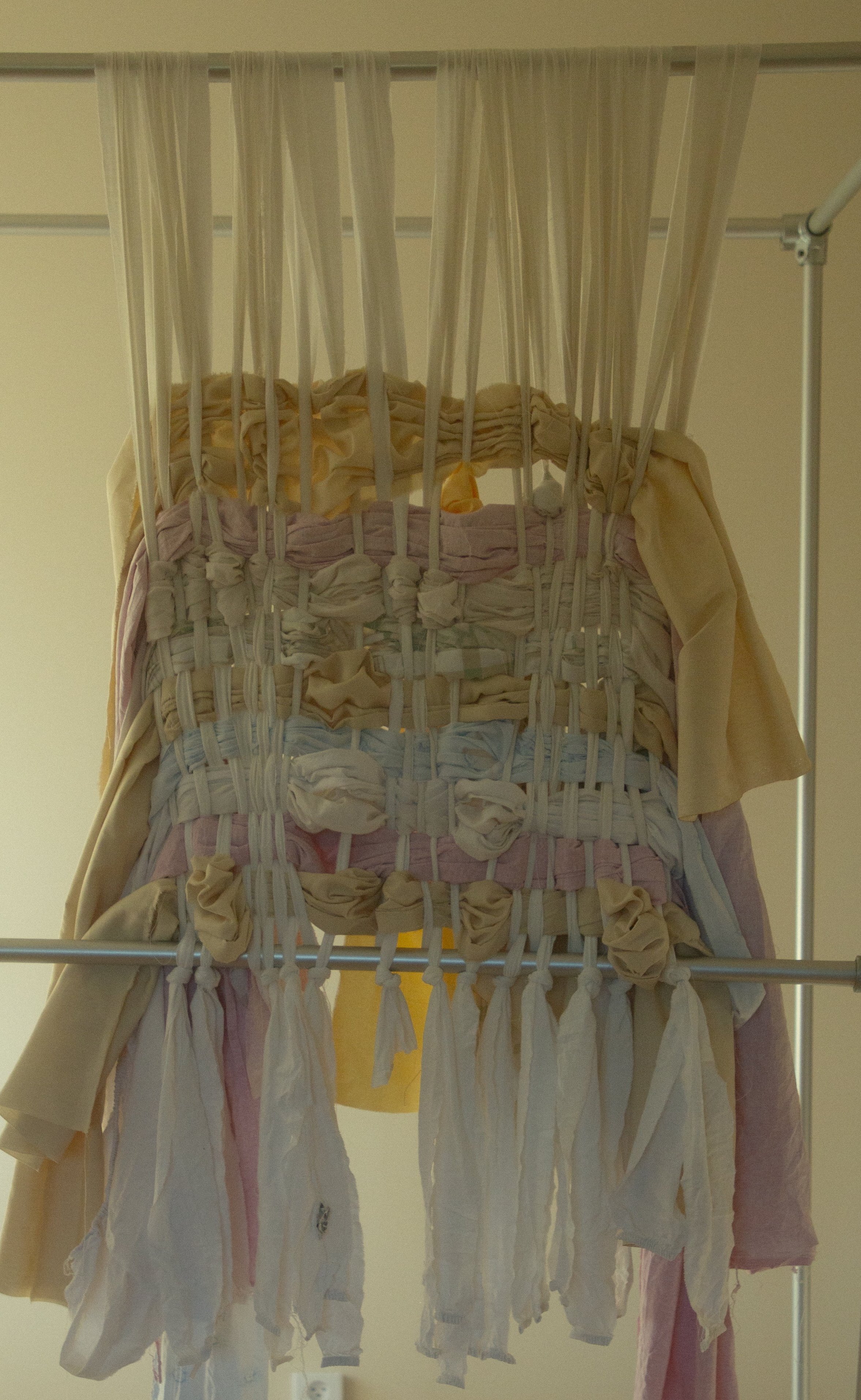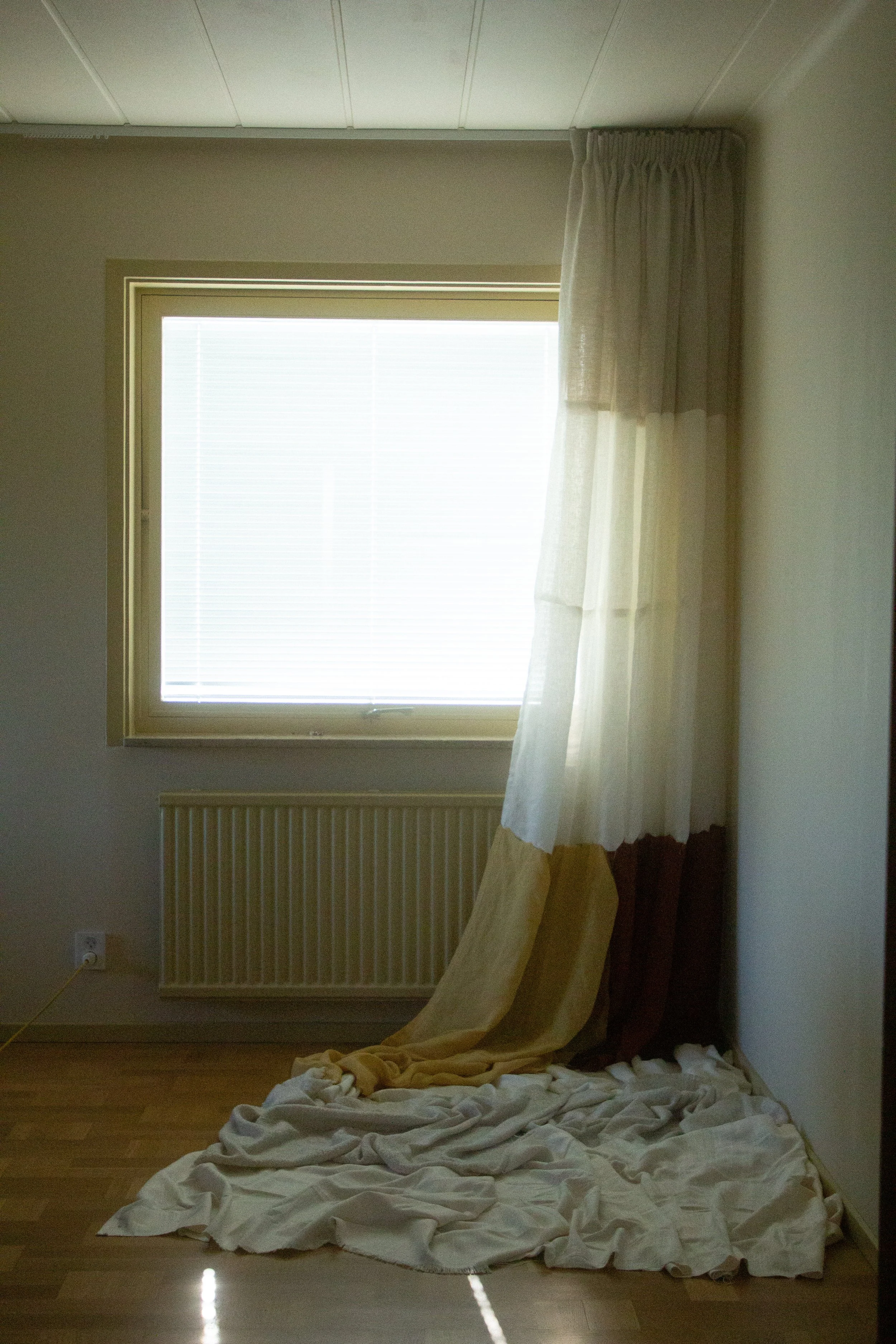Rewoven Realities
; transforming textile waste into an interactive narrative experience
Manifesto
Textile is a landscape of time, woven from history, labor, and touch. It surrounds us from birth to death, absorbing light, sound, and movement, shaping the way we experience the world. Yet, it is one of the first materials we discard—torn away, forgotten and replaced.
But textiles are not silent. They carry traces of presence, care, and the hands that have shaped them. A faded curtain remembers the light it once softened. A frayed hem holds the imprints of daily movements. A worn-out sheet carries the restless echoes of sleep.
Fibers absorb the smell of places and people, holding memories and history—as an archive of life. Slowly fading and being washed away, replaced with new life and DNA.
Softness is not weakness. Flexibility is not unstable. A woven thread is both structure and skin, a boundary and a connection. Textiles shape space—not only as decoration, but as architecture, as memory and as movement.
Every discarded textile is a forgotten story. To weave is to repair, to bind together, to make something whole again. Let us listen to the whispers of textiles, and to rediscover what has always been there—a material meant not for disposal, but for transformation over time.
The Objects
The De- Assambled Duvet
Once held together as one body, this discarded duvet has been carefully taken apart—its layers separated, its weight reduced, its form opened. The material is familiar: a domestic object found in nearly every home. Warmth, softness, and sleep live in its fibres.
A duvet is usually hidden—wrapped in covers, layered, and closed. Here, it is shown naked. Its inner filling is exposed. As two large textile panels, the material becomes a spatial filter. It catches and softens light like a quiet membrane.
When touched by daylight—or lighten up by projection—it glows. The material that once held rest now becomes active, responsive. It invites stillness again, but of another kind.
This object reminds us that even the most private materials hold spatial potential—that softness, when revealed, can shape both atmosphere and awareness.
SOURCE:
TEXTILE SORTING FACILITY
The Plain Weave
This piece is a large-scale interpretation of the plain weave—the most fundamental of textile structures. Strips of discarded bedsheets, collected from private homes, are woven by hand into a grid, where openings and overlaps invite light and air to move through.
The weave is simple, but not perfect. It tightens and it loosens—changing with gravity, with time, with handling. It opens and closes, never fixed.
Each strip carries traces of everyday life: softness, fading patterns, wear. Together, they create a surface that is at once structural and intimate—a slow rhythm of repetition, held together by hand.
Folded Layers
A soft mass, layered and compressed from discarded hotel sheets. What might otherwise remain folded in storage, or added to the growing piles of unused fabric, is here given shape.
This object represents the silent build-up of unused textiles —the bedsheets, clothes, and fabric that never make it back into circulation. As more textiles are collected, but not reused, they begin to form mountains: in warehouses, at sorting centres or maybe in your closet. Out of sight, but steadily growing.
It stands still and quiet—a monument of what happens to the textiles. It asks the viewer to hold this image of folded layers, to remember what is left behind when circulation stops..
Patchwork and Repairing Curtain
A patchwork curtain composed entirely of factory-cut textile waste. Each piece—a cut-off, a leftover, a misstep in production—was originally intended to become a curtain, but never did. Too small, too many, too irregular. Instead of reaching their intended purpose, they were set aside.
Now, together, they return as one. Stitched from textile pieces, the curtain is both reminder and proposal: that repair is not a compromise, and that these discarded parts can still become what they were meant to be.
This object celebrates slowness, repetition, and material care. It speaks to a culture of repairing and invites us to shift how we value leftovers: not as waste, but as material waiting for attention and potential.
Material Collection and Inventory
The materials used in this project were collected through four sources, each representing a different part of the textile system. These sources were selected to reflect a variety of values, uses, and material flows. Together, they have shaped the project’s material archive and contributed to a broader understanding of how textiles move through society.
They reveal how waste is generated at different scales—from individual routines to industrial operations—and how each discarded fabric carries not only physical properties, but also stories of use, exclusion, and potential reuse.
PRIVATE INDIVIDUALS
TEXTILE SERVICE PROVIDER
TEXTILE PRODUCER
TEXTILE SORTING FACILITY







